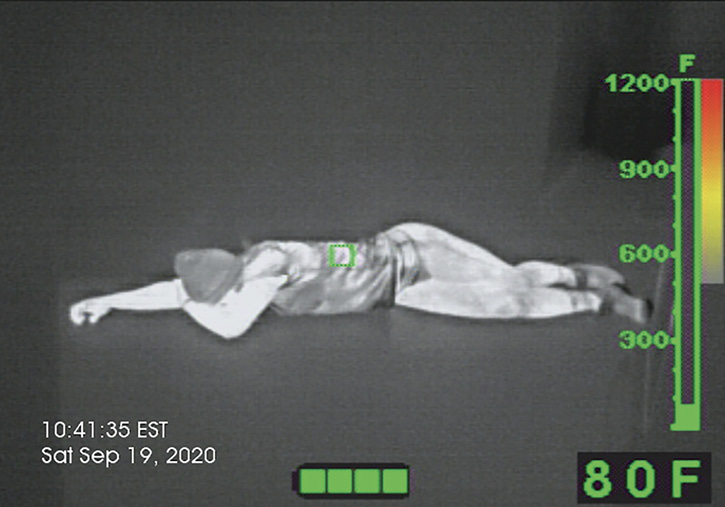
Using a fire service thermal imager (TI) to identify hoarders and hot bedding can be useful for first responders and fire departments. A good fire department captain friend of mine recently came up with a term, which he has coined “hot bedding.”
It describes what he is finding in a lot of residential neighborhoods. It is becoming a normal occurrence to find beds on every floor space in some homes and apartments. People use the space to sleep then go to work. The space can be considered occupied 24/7 because of a lack of affordable living space and low-paying jobs.

1 The latent heat signature of a person detected on a bed. (Photos courtesy of Bullard.)

2 An obvious victim detected lying on the floor.
He has had two occupancies where people on the outside of a building report everyone is out only for crews to find people sleeping on a mattress on the floor. The people residing like this do not know the other people staying in the residence and may not know if everyone is out. A good reminder to all is that a space is considered clear only when we search it and announce our search clear. “Hot bedding” is happening everywhere—cities, suburbs, towns, villages, and even rural properties.
Following are some helpful steps to follow.
- Acquire the necessary TI. Ensure that your fire department is equipped with a TI specifically designed for firefighting operations. These TIs should be advanced decision making units with high resolution and capable of detecting temperature variations.
- Understand thermal imaging. Familiarize yourself with how thermal imaging works. TIs detect and display heat signatures using infrared radiation. Hotter objects display as brighter or whiter, while cooler objects appear darker or black. Understanding how to interpret these thermal images is crucial.
- Establish operational guidelines and protocols. Develop specific operational guidelines and protocols for using the TI to locate hoarders and hot bedding in dwellings. Consult your department’s policies and legal experts to ensure compliance with privacy laws and residential rights.
- Train personnel. Train your firefighters on the proper use of TIs. Conduct hands-on training exercises that simulate different scenarios, including hoarding situations and hot bedding. Heat signatures can be residual whereas a person was there and has moved but the latent signature is still detectable. Identify victims by scanning each area and looking for obvious forms of a victim; unrecognizable forms that could be victims; and search areas that could contain a victim such as a bed, closet, or debris field. Remember that heat signatures can last from several minutes up to a half hour based on the room temperature, weight and size of a person, how long they were lying or sitting, and what they are lying or sitting on. Heat signatures can be masked or covered by thick bedding, clothing, or debris so look for feet or hands sticking out. If nothing is detectable, firefighters must conduct a manual search.
- Assess target areas. When responding to apartment complexes with suspected hoarders or hot bedding, evaluate the exterior and interior conditions before entering. Look for potential hazards such as blocked exits or obstructed hallways.
- Scan the premises. Use the TI to scan the apartment complex. Walk the hallways and visually inspect areas of interest, such as high-risk units or reported problem locations. The TI will help identify abnormal heat patterns that may indicate hoarding or hot bedding.
- Document findings. Record and document your findings using the TI, including images or video footage. This documentation may be necessary for legal or investigative purposes.
- Initiate appropriate actions. If evidence of hoarding or hot bedding is found, notify the building management or property owner, particularly if potential safety risks are identified. Follow standard procedures, which may include involving health or environmental agencies if required.
LIMITATIONS OF USING THERMAL IMAGING
Understand that every TI has limitations and is only as good as the operator who has sufficient training in its use.
- TIs cannot see through or around anything: walls, floors, thick debris, mounds of cardboard that can act as insulation, behind furniture, closet doors, and thick dividing curtains.
- Any shiny glossy surface will cause reflections: windows, mirrors, stainless steel appliances, gloss paints, shiny concrete, hardwood floors, ceramic tile.
- Atmospheric attention, steam, and fog can diminish image clarity—don’t forget to wipe both your display screen and front germanium lens.
- Bland temperature scenes: If everything in the room is the same temperature, it makes it hard to distinguish objects.
- Puddles of water or black holes in the floor cannot be accurately distinguished with a TI. Exercise caution.
Remember, while a TI can assist in identifying potential hoarding or hot bedding situations, its primary purpose is to detect heat, not to diagnose or judge behavior. Follow your fire department guidelines, as every room must be searched. You must scan, communicate, and conduct a hands-on search before declaring a room to be clear. Do not trust when outsiders are telling you that there is no one left within the structure.
MANFRED KIHN is a 19-year veteran of the fire service, having served as an ambulance officer, emergency services specialist, firefighter, captain, and fire chief. He has been a member of Bullard’s Emergency Responder team since 2005 and is the company’s fire training specialist for thermal imaging technology. He is certified through the Law Enforcement Thermographers’ Association (LETA) as a thermal imaging instructor and is a recipient of the Ontario Medal for Firefighters Bravery. If you have questions about thermal imaging, e-mail him at Manfred_kihn@bullard.com.

